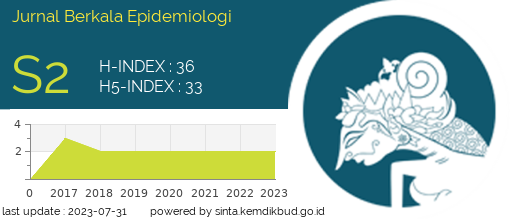The Effect of Low Birthweight on the Incidence of Neonatal Jaundice in Sidoarjo
Downloads
Background : The incidence of neonatal jaundice on low birth weight babies (BBLR) are mostly lead to mortality. A preliminary survey in the neonatal room of the public hospital (RSUD) Sidoarjo in January to December 2013 showed that there were 391 (12%) babies born with low birth weight from 3,210 natalities with 375 (9%) neonatal jaundice recorded from 3878 babies. Purpose: This study aimed to investigate the influence of low birth weight on the incidence of neonatal jaundice in RSUD Sidoarjo. Methods: The study design was a cross-sectional study with a total of 190 babies included as the study population. However, there were only 129 babies selected as respondents determined from solving formula with randomized sampling method. There were two variables measured in this study, namely low birth weight, and neonatal jaundice incidents. The secondary data were obtained from patients' medical records and were analyzed through a chi-square test to investigate the correlation between the two variables. Results: Results showed that the percentage of babies born with low birth weight was 21.71% and the neonatal jaundice was 29.46%. The number of babies suffered from neonatal jaundice with low birth weight was 17.80% with p=0.01. Conclusion:By all means, the low birth weight has a contribution in the incidence of neonatal jaundice in RSUD Sidoarjo.
Devi, D. S., & Vijaykumar, B. (2017). Risk factors for neonatal hyperbilirubinemia : a case control study. International Journal of Reproduction, Contraception, Obstetetric, Gynecology, 6(1), 198–202.
Diniya, N., Rahayu, A., & Musafaah. (2016). Faktor risiko yang berhubungan dengan berat badan bayi lahir rendah wilayah kerja Puskesmas Martapura Kabupaten Banjar. Jurnal Publikasi Kesehatan Masyarakat Indonesia, 3(3), 100–105.
Hafizah, & Imelda. (2013). Faktor-faktor yang berhubungan dengan kejadian hiperbilirubinemia di ruang Neonatal Intensive Care Unit (NICU) Rumah Sakit Umum Daerah Dr. Zainoel Abidin Banda Aceh. Undergraduated Thesis. Aceh: Fakultas Ilmu Kesehatan Universitas U'budiyah Indonesia.
Maulida, L. F. (2014). Ikterus neonatorum. Media Publikasi Penelitian, 10(1), 39–43. https://doi.org/10.26576/profesi.63
Pratama, A. N. (2013). Analisis faktor – faktor penyebab kejadian kematian neonatus di Kabupaten Boyolali. Undergraduated Thesis. Surakarta: Fakultas Ilmu Kesehatan Universitas Muhammadiyah Surakarta.
Pusparini, H., & Ariguntar, T. (2017). Gambaran kadar bilirubin pada ikterus neonatorum sebelum dan pasca fototerapi di Rumah Sakit Pertamina Cirebon periode Januari-Agustus 2014. Jurnal Ibnu Sina Biomedika, 1(2), 1–28. https://doi.org/10.1093/biolre/ioy009/4813327
Putri, S. D., & Rositawati, R. (2016). Hubungan BBLR dan asfiksia dengan kejadian ikterus neonatorum. Jurnal Obstretika Scientia, 4(2), 508–520.
Ratuain, M. O., Wahyuningsih, H. P., & Purmaningrum, Y. E. (2015). Hubungan antara masa gestasi dengan kejadian ikterus neonatorum. Kesehatan Ibu Dan Anak, 7(1), 51–54. https://doi.org/10.30604/jika.v2i1.35
Seriana, I., Yusrawati, & Lubis, G. (2015). Hubungan kadar Zink (Zn) serum ibu hamil aterm dengan berat badan lahir di RSUP Dr. M. Djamil Padang. Jurnal Kesehatan Ilmiah Nasuwakes, 8(1), 8–13.
Shinta, T. (2014). Pengaruh perubahan posisi tidur pada bayi baru lahir hiperbilirubinemia dengan fisioterapi terhadap kadar bilirubin total. Jurnal Kesehatan "Caring and Enthusiasm,” 1(2), 1–10.
Sholiha, H., & Sumarmi, S. (2015). Analisis risiko kejadian Berat Bayi Lahir Rendah (BBLR) pada primigravida. Jurnal Media Gizi Indonesia, 10(1), 57–63.
Slovin, M. J. (1960). Sampling. New York: Simon and Schuster Inc.
Sukla, K. K., Tiwari, P. K., Kumar, A., & Raman, R. (2013). Low birthweight (LBW) and neonatal hyperbilirubinemia (NNH) in an Indian cohort: association of homocysteine, its metabolic pathway genes and micronutrients as risk factors. PLoS ONE, 8(8), 1–8. https://doi.org/10.1371/journal.pone.0071587
Sulistyorini, D., & Siswoyo, S. (2014). Analisis faktor-faktor yang mempengaruhi kejadian BBLR di Puskesmas Perkotaan Kabupaten Banjarnegara. Jurnal Medsains, 1(1), 23–29.
Tazkiah, M., Wahyuni, C. U., & Martini, S. (2013). Determinan epidemologi kejadian BBLR pada daerah endemis malaria di Kabupaten Banjar Provinsi Kalimantan Selatan. Jurnal Berkala Epidemologi, 1(2), 266–276.
Tyas, S. C., & Notobroto, H. B. (2014). Analisis hubungan kunjungan neonatal, asfiksia dan BBLR dengan kematian neonatal, Surabaya. Jurnal Biometrika Dan Kependudukan, 3(2), 168–174.
Viswanath, D., Menon, V. V., Phabhuji, M., Kailasam, S., & Kumar, M. (2013). Neonatal jaundice. Journal of Indian Academy of Oral Medicine and Radiology, 25(3), 200–205. https://doi.org/10.3810/pgm.1999.11.775
Vivian, N. (2010). Asuhan neonatus bayi dan balita. Jakarta: Salemba Medika.
Widiawati, S. (2017). Hubungan sepsis neonatorum , BBLR dan asfiksia dengan kejadian ikterus pada bayi baru lahir. Riset Informasi Kesehatan, 6(1), 52–57.
Zuppa, A. A., Cavani, M., Riccardi, R., Catenazzi, P., Iafisco, A., & Vento, G. (2017). Immigrant newborn and physiological jaundice. Journal of Neonatal Biology, 6(2), 1–4. https://doi.org/10.4172/2167-0897.1000258
- Every manuscript submitted to must observe the policy and terms set by the Jurnal Berkala Epidemiologi
- Publication rights to manuscript content published by the Jurnal Berkala Epidemiologi is owned by the journal with the consent and approval of the author(s) concerned. (download copyright agreement)
- Complete texts of electronically published manuscripts can be accessed free of charge if used for educational and research purposes according to copyright regulations.

JBE by Universitas Airlangga is licensed under a Creative Commons Attribution-ShareAlike 4.0 International License.























